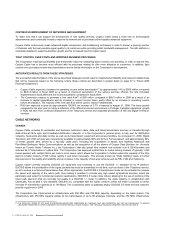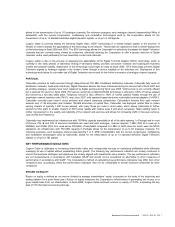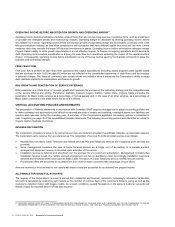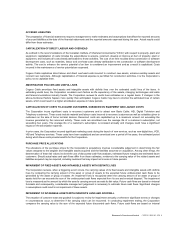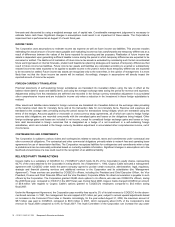Cogeco 2008 Annual Report Download - page 17
Download and view the complete annual report
Please find page 17 of the 2008 Cogeco annual report below. You can navigate through the pages in the report by either clicking on the pages listed below, or by using the keyword search tool below to find specific information within the annual report.16 COGECO CABLE INC. 2008 Management’s Discussion and Analysis
and Telecommunications Commission (“CRTC”) published its conclusions on October 30, 2008. The CRTC has decided not to
impose new fees for the carriage of the over-the-air television signals of Canadian conventional television stations by broadcasting
distribution undertakings. However, the CRTC has decided to impose a new remittance amounting to 1% of revenue derived from
the broadcasting activities of broadcasting distribution undertakings to a new independent fund with a view to supporting local
programming content of conventional television stations in smaller Canadian television markets. This remittance, which is in addition
to the current 5% Canadian program funding requirement applicable to broadcasting distribution undertakings, and which may not
be passed on to customers, will likely impact the Corporation’s regulatory costs starting with the next fiscal year. Other elements of
the CRTC policy statement, such as retransmission consent for Canadian distant signals, may also have an impact on costs. The
CRTC has launched several other material proceedings, including on the regulatory framework that should apply to VOD services
and the contribution that should be required from “new media” activities, such as the use of video content through Internet access
services.
The CRTC has forborne from regulating the residential and business local access telephone services of the incumbent telephone
companies in most of the geographic markets served by the Corporation in Ontario and Québec. As a result, Bell Canada and Telus
are now free to price and bundle their residential and business local access telephone services and to extend general or specific
promotional offers without prior regulatory approval in the forborne local exchange areas within the Corporation’s footprint.
The telecommunications markets in Portugal have been fully open to competition since January 1, 2000, and there are no foreign
ownership restrictions applying to electronic communications service providers or the ownership of broadband telecommunications
facilities in Portugal. Competitors are essentially free to bundle and price services based on competitive market considerations.
However, situations have arisen where either PT or Zon have been able to use their market power to respectively constrain access
to certain support structures and to a premium content service, Sport TV HD. These situations have been addressed through
complaints to the Autoridade da Concorrência (“AdC”) under applicable competition law, but the proceedings are still pending and
the final outcomes are not known at this time.
The European Commission launched, on June 29, 2006, a broad policy review initiative on electronic communications with a view to
boosting competition among telecommunications operators of EU member states and building a single market for services that use
radio spectrum. New EU telecommunications policy initiatives may eventually have an impact in the medium- to long-term on
Cabovisão’s electronic communications activities and the future state of competition for the provision of electronic communications
in Portugal.
RISKS PERTAINING TO OPERATING COSTS
Cogeco Cable applies itself to keeping its cost of goods sold in check so as to secure continued operating margin growth. The two
largest drivers of cost of goods sold are network fees paid to audio and television service suppliers as well as data transport and
connectivity charges, mostly for Telephony and HSI traffic.
The market for audio and video programming services in Canada is already characterized by high levels of supplier integration and
structural rigidities imposed by the CRTC’s regulatory framework for broadcasting distribution, which is presently under review.
While Cogeco Cable has been able to conclude satisfactory distribution agreements with Canadian and foreign programming
service suppliers to date, there is no assurance that network fees will not increase by larger increments in future years. There is also
no assurance that programming service suppliers will not change other material terms of distribution agreements or extend
preferences for the distribution of their content to competing distributors, or push for the distribution of their content over the Internet
in the future. In Portugal, the offering of new Digital audio and television services by Cabovisão requires the conclusion of suitable
arrangements with program suppliers. The negotiation of these arrangements is under way, but is not concluded as yet.
Since the markets for data transport and connectivity remain very competitive in Canada and Portugal, Cogeco Cable and
Cabovisão have negotiated cost effective arrangements in the past for voice and data traffic. However, as overall traffic increases
and capacity on existing broadband telecommunications facilities becomes more widely used, the Corporation may not be able to
secure further cost efficiencies in the future.
Furthermore, the Part II Licence Fees payable to the CRTC are currently under litigation. On December 14, 2006, the Federal Court
of Canada ruled that the Part II Licence Fees payable to the CRTC are an unlawful tax. Both the Plaintiffs (the members of the
Canadian Association of Broadcasters, Videotron Ltee and CF Cable TV Inc.) and the Defendant (the Crown) have appealed this
decision to the Federal Court of Appeal. The Defendant was seeking to reverse the Court decision that Part II Licence Fees are
unlawful and the Plaintiffs were seeking a Court order requiring a refund of past fees paid. The Appeal hearing was held on
December 4 and 5, 2007 in Ottawa and a decision was rendered on April 28, 2008 in favour of the Crown, to the effect that the fees
are valid regulatory charges. On June 26 and 27, 2008, the Plaintiffs filed applications for leave to appeal to the Supreme Court of
Canada. The Defendant filed its response on September 29, 2008 and the matter is currently pending. Cogeco Cable has accrued
the full amount with respect to these fees for fiscal years 2007 and 2008.


